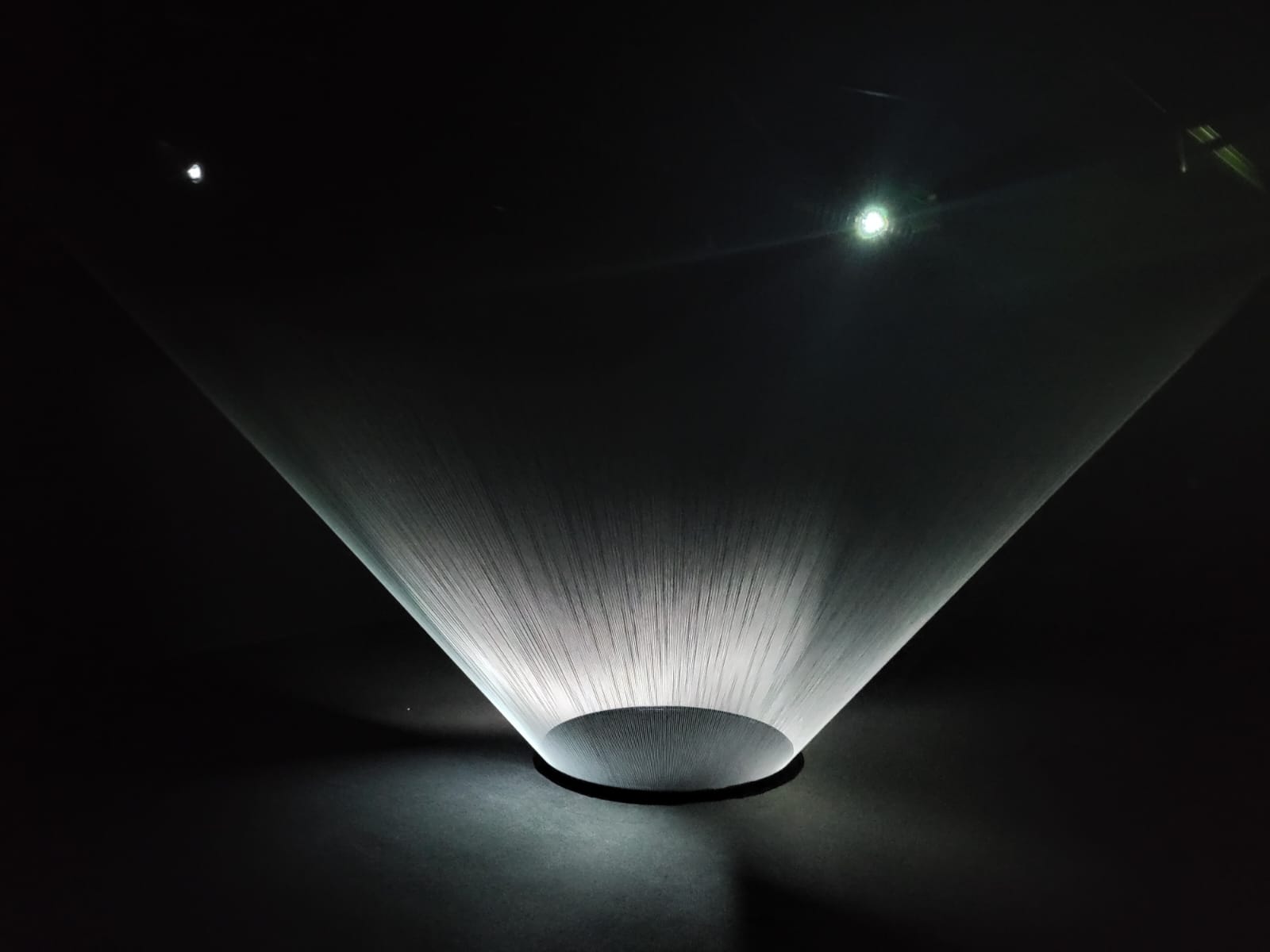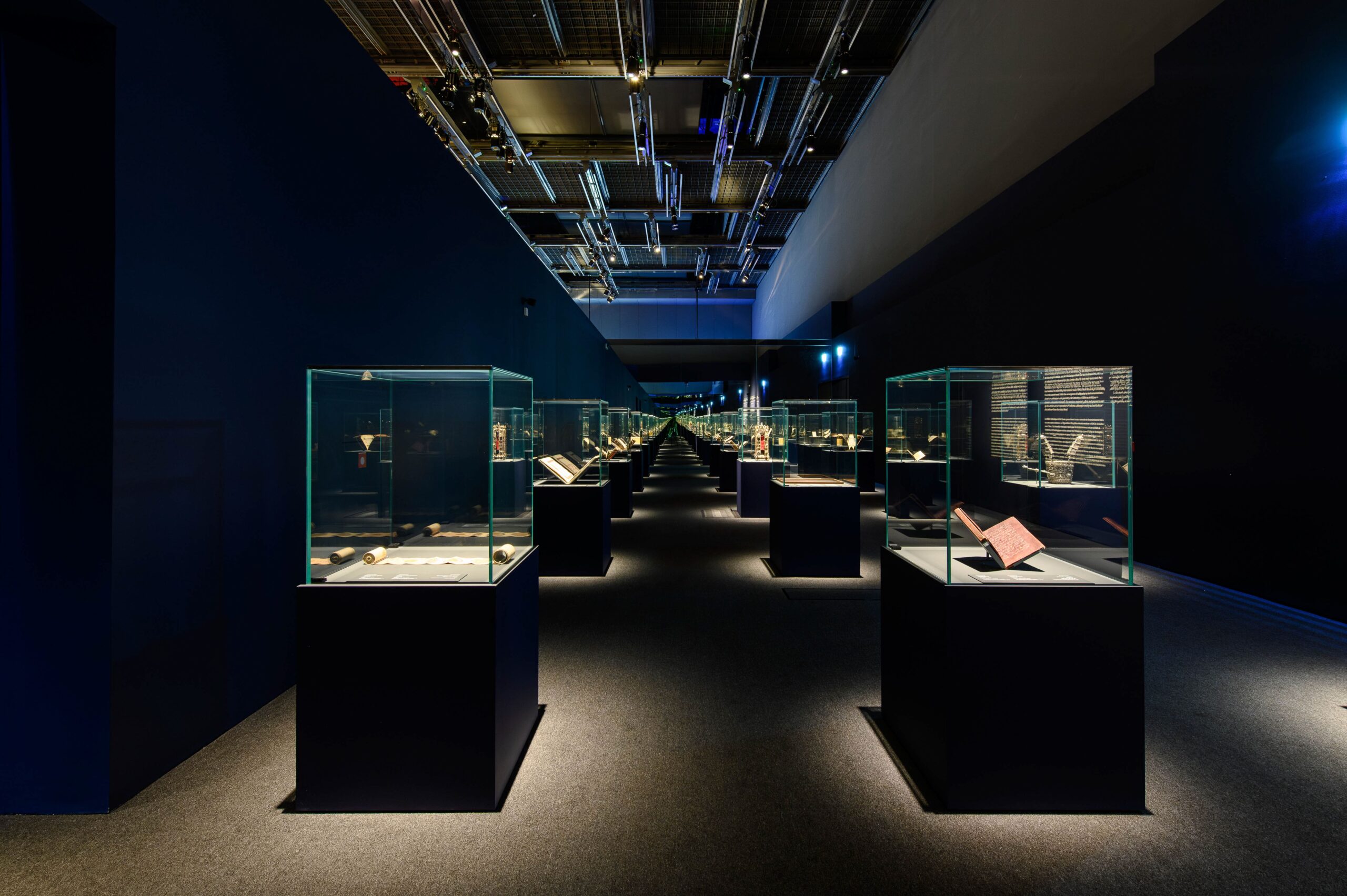Letters of Light: The role of interpretive design in creating the visitor experience
Jointly organised by the Bibliothèque Nationale de France, Louvre Abu Dhabi and France Muséums, the new temporary exhibition Letters of Light is being presented at Louvre Abu Dhabi from 13 September 2023 to 14 January 2024.
The aim of this exhibition is to bring together some of the oldest and most important examples of holy books from the three monotheistic religions: the Tanakh (Hebrew Bible), the Christian Bible and the Quran, revealing precious jewels of text illumination and calligraphy. Developed by Laurent Héricher, Head Curator, Head of the Oriental Manuscripts Department at the Bibliothèque Nationale de France, and Dr. Souraya Noujaim, Director of the Department of Islamic Artat the Musée du Louvre, this ambitious project highlights the origins and forms of sacred texts and the ways in which they have been passed down through the ages. Visitors are invited to discover the role of a selection of over 245 manuscripts and artworks in intellectual and artistic history.
The exhibition is in 5 parts covering the origins and birthplaces of the three monotheistic religions, the writing and establishment of literary canons, their worldwide dissemination, and the ways in which they are used by the faithful.
Challenges involved in the exhibition
As an international museum consultancy, France Muséums coordinated and supported the curatorial work, the production of the exhibition, the exhibition design, the interpretive development and planning, the artwork management and the catalogue, as well as training Louvre Abu Dhabi staff members. France Muséums paid particular attention to helping the Louvre Abu Dhabi teams to produce interpretive solutions for the exhibition. This collaboration also included the expansion of France Muséums training programs, tailored specifically for Louvre Abu Dhabi teams.
Around 245 exhibits have been brought together for this occasion, including 162 manuscripts, as well as archaeological objects, paintings, drawings, engravings and sculptures and a contemporary artwork. The exhibition, which occupies a total floor area of 1,400 square metres, presents civilizational, textual and linguistic histories which are intertwined and raise significant challenges in terms of sharing and mediation.
One of the major challenges of this project was to share objective knowledge on the history of the sacred texts while completely respecting the freedom of conscience of all visitors. The frame of reference of the exhibition is thus knowledge rather than belief. An additional layer of difficulty relates to the very nature of the books and objects on display. Manuscripts must be exhibited in specific conditions: light levels, methods of presentation in display cases and the angle of opening of books are all constraints that add to the challenges of understanding.
The wide range of languages exhibited as part of the exhibition—Arabic, Hebrew, Latin, Greek, Coptic, Syriac—also forms a barrier to understanding the books. These challenges combined constitute a paradox that is hard to resolve: the fragility of the books makes it necessary to immobilise and protect the pages of the manuscript, making reading into a collective experience rather than a personal one; this can be rather disappointing for the visitor.
The role of interpretive design in creating the visitor experience
Mediation is crucial to make content accessible, to create an immersive visitor experience and to spark interest and curiosity. How can we engage with our audience and create a genuine visitor experience in a large exhibition area where a range of similar objects are presented behind glass? How can we provide the necessary precise information and cross-referenced historical and geographical contexts without overloading our visitors? How can we provide opportunities for contemplation?
The France Muséums teams have worked hard at developing simple, uncluttered, immersive and informative solutions using signage, interpretive tools, educational resources and exhibition design to provide a unique experience geared towards contemplation, discovery and a feeling of wonder.
SIGNAGE AND INTERPRETIVE TOOLS
To take account of the complexity of the subject and to ensure that the different elements punctuating the visit are as effective as possible, the France Muséums mediation teams collaborated with numerous experts from cultural associations and institutions specialising in the presentation of interfaith material. This resulted in several interpretive solutions such as extended exhibit captions.
A themed leaflet provided at the entrance invites visitors to explore a specific selection of exhibits leading them to focus in particular on 6 selected themes (light, colour, materials, format, languages and calligraphy). They are then guided by a series of questions and comparisons that encourage them to look at the exhibits in different ways and to identify parallels between the three religious traditions. Among the digital and low-tech interpretive tools produced for the exhibition, France Muséums wanted to focus on universally recognised educational formats such as illustrated timelines and animated maps. Focusing on particular manuscripts provides the opportunity for visitors to take a more detailed look at them, highlighting their superb colours and intricate calligraphy. Last but not least, a monumental immersive 180° projection gives visitors a chance to pause for a moment and meditate. This installation makes it possible to perceive the three monotheistic religions in a different way, to gain a better understanding of their traditions and to explore how they contribute to the spiritual lives of the faithful.
EXHIBITION DESIGN
The overall exhibition design also plays a central role in the Letters of Light visitor experience. It is the result of a collaboration between team members from the BnF, Louvre Abu Dhabi, France Muséums and the scenographic group headed by the FREAKS scenographic company, assisted by the Opixido agency for the graphic design and interpretation.
The design for this new exhibition focuses on creating a powerful audio-visual environment. The visitor pathway has been constructed around the hours of the day and the notion of the passage of time. Its muted colour scheme encourages meditation and quiet contemplation. A soundtrack reflecting the atmosphere of each section was specially designed by a sound engineer.
The result is an innovative, elegant design that highlights the themes of the exhibition and creates a harmonious balance between the preservation of traditions and the need to engage with visitors.
Training: a central challenge for an engaging visitor experience
Among its many missions, France Muséums works with the Louvre Abu Dhabi on providing professional training and skills transfer in museum-related subjects. For each new international exhibition, France Muséums trains mediators and security staff on how to use the tools that provide the best possible conditions for visitors. To achieve this, France Muséums relies on its network of French national museums to provide the relevant technical and scientific training.
Where Letters of Light is concerned, some of the mediation training provided by France focused specifically on manuscripts. During these mentoring sessions, visiting experts from the Bibliothèque Nationale de France and museum mediation staff were able to share their experience and recommendations on new ways of interacting with these types of objects depending on different visitor profiles. The training concluded with a series of role plays in the museum’s permanent galleries, and a brainstorming session was devoted to the development of creative workshops for families and schoolchildren.
The visitor experience team supports the France Muséums training team by creating a range of training media, such as summaries of detailed guided visits, to be used during these sessions. At-a-glance notes provide the mediator with several proposals for visitor pathways through the exhibition. In addition to these documents, one-to-one and group training sessions are provided while the exhibition is being installed, providing a space for useful interprofessional dialogue. We are proud to be able to contribute to these knowledge-sharing initiatives.
The exhibition Letters of Light at the Louvre Abu Dhabi celebrates the very essence of humanity in its rich diversity, encouraging tolerance, mutual understanding and intercultural dialogue. Our role at France Muséums is to facilitate and shape encounters between exhibits and the visitors who come to admire and better understand them. We intervene from the earliest stages of the exhibition project, offering accessible and coherent interpretive solutions that are relevant to the exhibition’s scientific content and which help it to engage with the widest possible audience.
Find out how France Muséums develops develops dedicated universes to enrich the visitor experience.
This project would not have been possible without the multi-skilled France Muséums team: Adrien Berthelot, Programming and Production Director; Maud Ramier, Project Manager; Solène Mannant, Temporary Exhibition Officer; Mihai Voicu, Operations Manager; Anaïs Desneaux, Artwork Registrar; Chloé Guillaume, Artwork Registrar; Orlane Lefeuvre, Mediation and Programming Officer; Charlotte Clergeau, Digital Project Officer; Zeynep Inanc, independent Museum Operations Project Manager; and Marine Pajaud, Publishing and Exhibitions Assistant, along with their partners. We would also like to thank the exhibition associated curators Dr. Sabine Maffre, Library Curator, Collections Manager, Medieval Manuscripts at the Bibliothèque Nationale de France; Dr. Khalid Chakor-Alami, Collections Manager, Arab Manuscriptsat the Bibliothèque Nationale de France; and Mariam AlDhaheri, Curatorial Assistant at Louvre Abu Dhabi, as well as all the Louvre Abu Dhabi teams, especially Rajeev Gopinadh, Manager, Temporary Exhibitions and Special Projects, and Alice Querin, Unit Head, Temporary Exhibitions, for the management of this exhibition.





